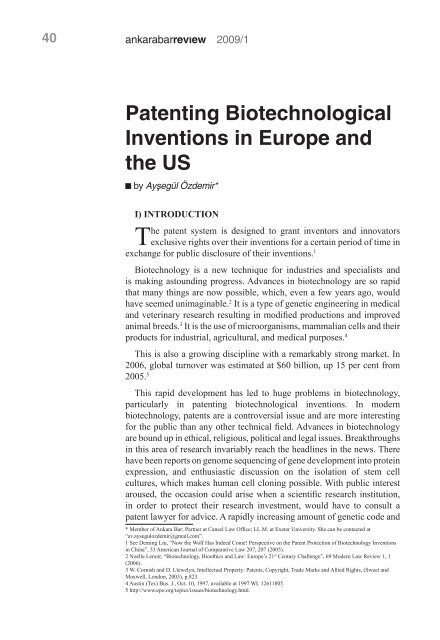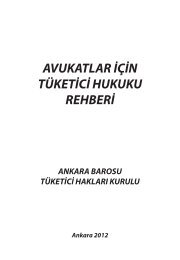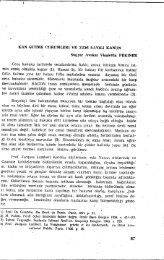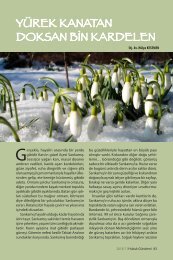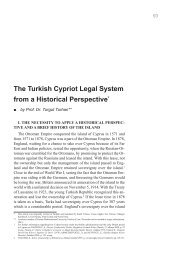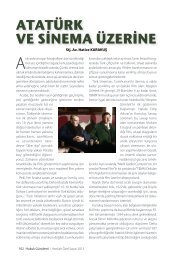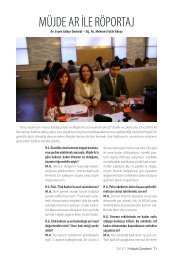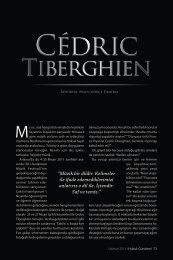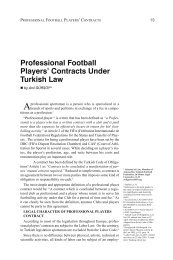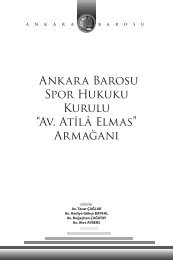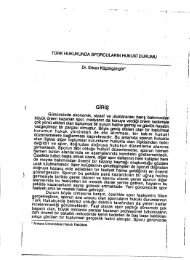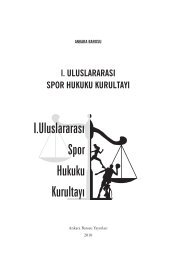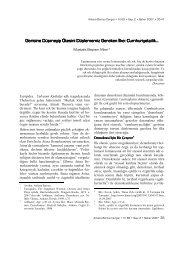Patenting Biotechnological Inventions in Europe ... - Ankara Barosu
Patenting Biotechnological Inventions in Europe ... - Ankara Barosu
Patenting Biotechnological Inventions in Europe ... - Ankara Barosu
You also want an ePaper? Increase the reach of your titles
YUMPU automatically turns print PDFs into web optimized ePapers that Google loves.
40<br />
ankarabarrevıew 2009/1<br />
<strong>Patent<strong>in</strong>g</strong> <strong>Biotechnological</strong><br />
<strong>Inventions</strong> <strong>in</strong> <strong>Europe</strong> and<br />
the US<br />
by Ayşegül Özdemir*<br />
I) INTRODUCTION<br />
The patent system is designed to grant <strong>in</strong>ventors and <strong>in</strong>novators<br />
exclusive rights over their <strong>in</strong>ventions for a certa<strong>in</strong> period of time <strong>in</strong><br />
exchange for public disclosure of their <strong>in</strong>ventions. 1<br />
Biotechnology is a new technique for <strong>in</strong>dustries and specialists and<br />
is mak<strong>in</strong>g astound<strong>in</strong>g progress. Advances <strong>in</strong> biotechnology are so rapid<br />
that many th<strong>in</strong>gs are now possible, which, even a few years ago, would<br />
have seemed unimag<strong>in</strong>able. 2 It is a type of genetic eng<strong>in</strong>eer<strong>in</strong>g <strong>in</strong> medical<br />
and veter<strong>in</strong>ary research result<strong>in</strong>g <strong>in</strong> modified productions and improved<br />
animal breeds. 3 It is the use of microorganisms, mammalian cells and their<br />
products for <strong>in</strong>dustrial, agricultural, and medical purposes. 4<br />
This is also a grow<strong>in</strong>g discipl<strong>in</strong>e with a remarkably strong market. In<br />
2006, global turnover was estimated at $60 billion, up 15 per cent from<br />
2005. 5<br />
This rapid development has led to huge problems <strong>in</strong> biotechnology,<br />
particularly <strong>in</strong> patent<strong>in</strong>g biotechnological <strong>in</strong>ventions. In modern<br />
biotechnology, patents are a controversial issue and are more <strong>in</strong>terest<strong>in</strong>g<br />
for the public than any other technical field. Advances <strong>in</strong> biotechnology<br />
are bound up <strong>in</strong> ethical, religious, political and legal issues. Breakthroughs<br />
<strong>in</strong> this area of research <strong>in</strong>variably reach the headl<strong>in</strong>es <strong>in</strong> the news. There<br />
have been reports on genome sequenc<strong>in</strong>g of gene development <strong>in</strong>to prote<strong>in</strong><br />
expression, and enthusiastic discussion on the isolation of stem cell<br />
cultures, which makes human cell clon<strong>in</strong>g possible. With public <strong>in</strong>terest<br />
aroused, the occasion could arise when a scientific research <strong>in</strong>stitution,<br />
<strong>in</strong> order to protect their research <strong>in</strong>vestment, would have to consult a<br />
patent lawyer for advice. A rapidly <strong>in</strong>creas<strong>in</strong>g amount of genetic code and<br />
* Member of <strong>Ankara</strong> Bar; Partner at Cansel Law Office; LL.M. at Exeter University. She can be contacted at<br />
“av.aysegulozdemir@gmail.com”.<br />
1 See Dem<strong>in</strong>g Liu, “Now the Wolf Has Indeed Come! Perspective on the Patent Protection of Biotechnology <strong>Inventions</strong><br />
<strong>in</strong> Ch<strong>in</strong>a”, 53 American Journal of Comparative Law 207, 207 (2005).<br />
2 Noelle Lenoir, “Biotechnology, Bioethics and Law: <strong>Europe</strong>’s 21 st Century Challenge”, 69 Modern Law Review 1, 1<br />
(2006).<br />
3 W. Cornish and D. Llewelyn, Intellectual Property: Patents, Copyright, Trade Marks and Allied Rights, (Sweet and<br />
Maxwell, London, 2003), p.823.<br />
4 Aust<strong>in</strong> (Tex) Bus. J., Oct. 10, 1997, available at 1997 WL 12611805.<br />
5 http://www.epo.org/topics/issues/biotechnology.html.
paTenTIng BIoTechnologIcal InvenTIons In europe anD The us<br />
sequenc<strong>in</strong>g material is be<strong>in</strong>g patented provided that the patent is not so<br />
biotechnologically broad that it creates a monopoly or illegitimate patent<br />
production based on lack of product or potential product specificity. 6<br />
Consequently, the idea that breakthroughs <strong>in</strong> genetic knowledge could<br />
be monopolized by a few mult<strong>in</strong>ational companies is a major cause of<br />
concern.<br />
Throughout the world, patent offices, legislators and courts are deeply<br />
<strong>in</strong>volved with these issues. Legal answers are more likely to be reached<br />
than political or ethical considerations satisfied. The ethics surround<strong>in</strong>g<br />
these issues must not be ignored nor can they be an obstacle to legal<br />
provision for potential <strong>in</strong>ventions.<br />
II) HISTORICAL REVIEW<br />
Inventors have been fil<strong>in</strong>g applications for biotechnological patents for<br />
over a hundred years. Patent No. 3, granted <strong>in</strong> F<strong>in</strong>land on 8 November<br />
1843, <strong>in</strong>troduced a novel method to produce yeast cultures. On 29 July<br />
1873, microbiologist Louis Pasteur obta<strong>in</strong>ed a patent from the French<br />
Patent Office for his improved yeast-mak<strong>in</strong>g method. 7<br />
In the last 50 years, very important biological advancements have taken<br />
place. Biological advancements usually require substantial <strong>in</strong>vestment for<br />
research. Therefore, <strong>in</strong>vestors turn to Intellectual Property Rights (IPRs),<br />
particularly patent systems, <strong>in</strong> the hopes of <strong>in</strong>sur<strong>in</strong>g their rights over their<br />
<strong>in</strong>vestment. In this way, the concerns of biotechnological research, its<br />
<strong>in</strong>ventions, and IPRs are closely l<strong>in</strong>ked.<br />
The United States was the first <strong>in</strong> the field with its decisions regard<strong>in</strong>g<br />
the patent<strong>in</strong>g of “liv<strong>in</strong>g matter.” Early patents from the US were granted<br />
for bacterial and viral vacc<strong>in</strong>es. Until the 1980s, it was usually agreed that<br />
“liv<strong>in</strong>g th<strong>in</strong>gs” were not patentable. This policy was revised <strong>in</strong> the 1980<br />
landmark case of Diamond v. Chakrabarty. The <strong>in</strong>vention concerned the<br />
discovery of a genetically-altered bacterium, which, when modified, could<br />
break down crude oil. As the US Supreme Court famously noted <strong>in</strong> this<br />
case, it now seemed possible to issue patents on “anyth<strong>in</strong>g under the sun<br />
that is made by man.” 8 The Court decided that Chakrabarty’s <strong>in</strong>vention<br />
was not a “product of nature” but a “man-made” bacterium, which did<br />
not occur naturally <strong>in</strong> nature. Thus, the court stated, it was “not nature’s<br />
handiwork, but Amanda Chakrabarty’s own; accord<strong>in</strong>gly the Court held it<br />
was patentable subject matter.” 9 Thus, from then on, an <strong>in</strong>vention <strong>in</strong>volv<strong>in</strong>g<br />
a liv<strong>in</strong>g organism could fulfill the criteria to be patentable subject matter,<br />
s<strong>in</strong>ce a genetically modified bacterium, a bioeng<strong>in</strong>eered microbe, had<br />
been created to provide a useful function – to dissolve oil.<br />
In the 1987 case of Ex parte Allen, the Board of Patent Appeals<br />
and Interferences ruled that polyploid oysters conta<strong>in</strong><strong>in</strong>g three sets of<br />
6 John Sal<strong>in</strong>as Lopez, “Should Genetic Code Be Patented?,” Law and Society Review at UCSB, Vol.1 (2002) Genetic<br />
Code 57.<br />
7 http://www.epo.org/topics/issues/biotechnology.html.<br />
8 447 U.S. 309 (1980).<br />
9 Ibid. at 310.<br />
41
42<br />
ankarabarrevıew 2009/1<br />
chromosomes <strong>in</strong>stead of two were patentable subject matter. 10 The decision<br />
resulted <strong>in</strong> the United States Patent and Trademark Office (USPTO)<br />
mak<strong>in</strong>g an announcement that thereafter it would consider “non-naturally<br />
occurr<strong>in</strong>g, non-human multicellular liv<strong>in</strong>g organisms, <strong>in</strong>clud<strong>in</strong>g animals,<br />
to be patentable subject matter with<strong>in</strong> the scope of the Statute.” 11 Only one<br />
year later, <strong>in</strong> 1988, the first patent on a mammal was granted <strong>in</strong> the U.S.<br />
for the Harvard mouse (US Patent 4,736,866). Many patent applications<br />
<strong>in</strong> the U.S. have followed for genetically modified animals. The same case<br />
underwent a very complex process before it was f<strong>in</strong>ally granted a patent<br />
<strong>in</strong> 2004. The <strong>Europe</strong>an equivalent to the US Chakrabarty case was the<br />
“Rote Taube” decision. 12 In this case, the patent application was refused<br />
because of difficulties <strong>in</strong> reproduc<strong>in</strong>g the <strong>in</strong>vention but it was accepted<br />
that a process of animal breed<strong>in</strong>g based on classical crosses and selection<br />
could be patentable material.<br />
In 1973, the <strong>Europe</strong>an Patent Office established the <strong>Europe</strong>an Patent<br />
Convention (EPC), based on established national laws. Biotechnology,<br />
although a develop<strong>in</strong>g new field that is mak<strong>in</strong>g discoveries that could<br />
never have been foreseen, is dealt with by a traditional body of law.<br />
In July 1998, EU Directive 98/44/EC on the legal protection of<br />
biotechnological <strong>in</strong>ventions, known as the “Biotech Patent Directive”<br />
was adopted. Its purpose was to clarify the dist<strong>in</strong>ction between what is<br />
patentable and what is not. 13<br />
III) IMPORTANCE OF PATENTS IN THE FIELD OF<br />
BIOTECHNOLOGY<br />
The major reason that <strong>in</strong>ventors apply for patents is to protect their<br />
control over the technologies that they have <strong>in</strong>vented. However there<br />
are also other reasons. A large patent portfolio is considered to be an<br />
<strong>in</strong>dication of a strong company and can put companies <strong>in</strong> an advantageous<br />
position to attract <strong>in</strong>vestors and collaboration partners. Although there is<br />
the oppos<strong>in</strong>g argument that the costs of patent<strong>in</strong>g and the requirement to<br />
disclose technical <strong>in</strong>formation are disproportionally large <strong>in</strong> comparison<br />
to the benefits, it is nonetheless clear that biotechnological <strong>in</strong>ventions<br />
are patented extensively. In addition to this, companies derive great<br />
advantages from cross-licenses and the ability to underm<strong>in</strong>e competitors.<br />
So the ma<strong>in</strong> object seems to be, not the protection of the technology per<br />
se, but the restriction of competition.<br />
Patents are the most appropriate way of protect<strong>in</strong>g biotechnological<br />
<strong>in</strong>ventions. Other methods of protection, such as trademarks and trade<br />
secrets, are less relevant for biotechnological <strong>in</strong>ventions because of the ease<br />
with which drugs can be copied through chemical reverse eng<strong>in</strong>eer<strong>in</strong>g.<br />
10 2 USPQ 2d, 1425 (PTO Bd. Pat. App. & Int., 1987).<br />
11 USPTO, April 21, 1987.<br />
12 BGH, Beschluss vom 27.03.1969 – X ZB 15/67 (BPatG).<br />
13 http://www.epo.org/topics/issues/biotechnology.html.
paTenTIng BIoTechnologIcal InvenTIons In europe anD The us<br />
IV) PATENTABLE SUBJECT MATTER<br />
Accord<strong>in</strong>g to Article 27.1 of the WTO Trade Related Intellectual<br />
Property Rights (TRIPS) Agreement, “patents shall be available for any<br />
<strong>in</strong>ventions, whether products or processes, <strong>in</strong> all fields of technology,<br />
provided that they are new, <strong>in</strong>volve an <strong>in</strong>ventive step and are capable of<br />
<strong>in</strong>dustrial application.” These requirements are arranged <strong>in</strong> all national<br />
legislation schemes <strong>in</strong> different provisions. Besides, these traditional<br />
requirements <strong>in</strong> the field of biotechnology there may be other requirements<br />
for the patent<strong>in</strong>g procedure. Investors plann<strong>in</strong>g to obta<strong>in</strong> patent protection<br />
for biological <strong>in</strong>ventions may confront different legal systems, patent<br />
authorities, substantive and procedural requirements, s<strong>in</strong>ce the field is<br />
territorial <strong>in</strong> nature<br />
A) Most relevant provisions regard<strong>in</strong>g biotechnological <strong>in</strong>ventions<br />
1) <strong>Europe</strong>: <strong>Europe</strong>an Patent Convention Art. 52-57, 83, 84; Rules 23<br />
b-e, 28 and Directive 98/44/EC<br />
2) US: Title 35 United States Constitution Section 101-103, 112,<br />
287(c)<br />
B) Prerequisites of patentable subject matter<br />
For a liv<strong>in</strong>g th<strong>in</strong>g to be patentable, it must meet two prerequisites of<br />
patentable subject matter. The liv<strong>in</strong>g th<strong>in</strong>g must be an “<strong>in</strong>vention” with<strong>in</strong> a<br />
“patentable class.” In all national legislation schemes, these prerequisites<br />
must be <strong>in</strong> place for a patent to be granted for a biotechnological <strong>in</strong>vention.<br />
Each of them will be exam<strong>in</strong>ed by focus<strong>in</strong>g on the legislation separately.<br />
1) First prerequisite – the dist<strong>in</strong>ction between <strong>Inventions</strong> and<br />
Discoveries<br />
The specific def<strong>in</strong>ition of an <strong>in</strong>vention is not <strong>in</strong>cluded either <strong>in</strong> the United<br />
States Patent Act or <strong>in</strong> the <strong>Europe</strong>an Patent Convention and discoveries<br />
are excluded from patentability. 14<br />
a) The United States<br />
To be eligible for a patent, an <strong>in</strong>vention must fit with<strong>in</strong> one of the<br />
statutory categories of patentable subject matter established <strong>in</strong> Section<br />
101 of the US Patent Act:<br />
Whoever <strong>in</strong>vents or discovers any new and useful process, mach<strong>in</strong>e,<br />
manufacture, or composition of matter or any new and useful improvement<br />
thereof, may obta<strong>in</strong> a patent therefore, subject to the conditions and<br />
requirements of this title. 15<br />
The case of Diamond v. Chakrabarty was the first time a court made<br />
14 Convention on the Grant of <strong>Europe</strong>an Patents (5 October, 1973, Munich; as amended for the last time 10 December,<br />
1998) Art. 52. Patentable <strong>in</strong>ventions are described by giv<strong>in</strong>g the list of exclusions that “shall not be regarded as <strong>in</strong>ventions:<br />
(...) (a) discoveries, scientific theories and mathematical methods;(b) aesthetic creations; (c) schemes, rules and<br />
methods for perform<strong>in</strong>g mental acts, play<strong>in</strong>g games or do<strong>in</strong>g bus<strong>in</strong>ess, and programmes for computers; (d) presentations<br />
of <strong>in</strong>formation.<br />
15 5 U.S.C. Section 101.<br />
43
44<br />
ankarabarrevıew 2009/1<br />
a decision to change the paradigm of enquiry for biotechnological<br />
<strong>in</strong>ventions. The mean<strong>in</strong>g of the statute was clarified <strong>in</strong> a broad sense for<br />
biological <strong>in</strong>ventions <strong>in</strong> the Chakrabary decision. The U.S. Supreme<br />
Court decided <strong>in</strong> this case that “anyth<strong>in</strong>g under the sun that is made by<br />
man” is patentable subject matter.<br />
Accord<strong>in</strong>g to the court decision, what is needed to evaluate<br />
biotechnological patent claims is to determ<strong>in</strong>e whether a product is of<br />
a liv<strong>in</strong>g nature, or is of human <strong>in</strong>vention, rather than of mak<strong>in</strong>g one’s<br />
judgment based on whether the product is liv<strong>in</strong>g or <strong>in</strong>animate. Apply<strong>in</strong>g<br />
this criteria means natural products can be seen to be biologically active<br />
substances or chemical compounds and not merely as products of nature.<br />
Thus, the issue is already settled. As long as the liv<strong>in</strong>g matter applications<br />
under 35 USC Section 101 are a product of human <strong>in</strong>genuity – viruses,<br />
s<strong>in</strong>gle cells or multicellular organisms, they, can, like plants and nonhuman<br />
animals be considered to be liv<strong>in</strong>g matter.<br />
A common issue aris<strong>in</strong>g from biological <strong>in</strong>ventions is the problem<br />
of novelty and the dist<strong>in</strong>ction between discovery and <strong>in</strong>vention. Pure<br />
products of nature are not patentable. In order for the subject matter of<br />
natural orig<strong>in</strong> to be patentable under 35 U.S.C. Section 102, a human<br />
be<strong>in</strong>g must impart a new form, a new quality, at least one new property, or<br />
comb<strong>in</strong>ations thereof, to the orig<strong>in</strong>al product exist<strong>in</strong>g <strong>in</strong> nature. The ma<strong>in</strong><br />
issue regard<strong>in</strong>g patentability of biotechnological <strong>in</strong>ventions concerns the<br />
extent to which they are made publicly available and how the claimed<br />
<strong>in</strong>ventions are different from what is found <strong>in</strong> nature. Products, which<br />
have a higher purity or activity from the orig<strong>in</strong>al, have dist<strong>in</strong>guish<strong>in</strong>g<br />
physical properties or a different physical form may be patentable.<br />
b) <strong>Europe</strong><br />
“Discoveries (...) shall not be regarded as <strong>in</strong>ventions.” 16<br />
Similarly <strong>in</strong> <strong>Europe</strong>, just as there is <strong>in</strong> the US, there is a legal objection<br />
to allow<strong>in</strong>g patents for liv<strong>in</strong>g th<strong>in</strong>gs. This view is based on the “product of<br />
nature” doctr<strong>in</strong>e. If a new property of a known article or of a previously<br />
recognized substance exist<strong>in</strong>g <strong>in</strong> nature is found, it is a “discovery” and<br />
not patentable as such. 17 However, if an applicant proves that a substance<br />
found <strong>in</strong> nature can be put to a new use (for example, a micro-organism X<br />
is proved to be useful <strong>in</strong> diagnos<strong>in</strong>g Y disease) or if another technical effect<br />
is established, then such a “liv<strong>in</strong>g th<strong>in</strong>g” and its use may be patentable as<br />
an <strong>in</strong>vention. 18 Thus, the concept that ‘discovery’ is necessary <strong>in</strong> order for<br />
a patent to be granted is <strong>in</strong>terpreted narrowly under the EPC as well as<br />
other exclusions.<br />
A lead<strong>in</strong>g decision on patentability of naturally-occurr<strong>in</strong>g substances<br />
and the dist<strong>in</strong>ction between discovery and <strong>in</strong>vention was made by the<br />
16 EPC, Convention on the Grant of <strong>Europe</strong>an Patents, Art.52 (2) (a).<br />
17 Guidel<strong>in</strong>es for Exam<strong>in</strong>ation, Part C, Chapter IV, Section 2.3; http://www.european-patent-office.org/legal/ gui_l<strong>in</strong>es/<br />
<strong>in</strong>dex.htm.<br />
18 Ibid.
paTenTIng BIoTechnologIcal InvenTIons In europe anD The us<br />
German BpatG (Bundespatentgericht) <strong>in</strong> the Antamanid case. 19 The<br />
decision made clear that substances occurr<strong>in</strong>g naturally are patentable if<br />
they are new and have been isolated by technical means. It also has to<br />
be publicly available <strong>in</strong> that form and that it could not have been found<br />
without technical <strong>in</strong>tervention. An isolated gene, which is identical to the<br />
gene found <strong>in</strong> nature, may be patentable if the gene sequence has never<br />
been isolated before.<br />
Article 3 of the Directive makes it clear that once the criteria have been<br />
met, the biological products or material, or a process by means of which<br />
it is produced, processed or used, is patentable. The isolated element of<br />
the human body is only patentable <strong>in</strong> its natural state. The factors that<br />
make the element so are the technical processes used to identify purity and<br />
classify it and to reproduce it outside the human body, techniques which<br />
human be<strong>in</strong>gs alone are capable of putt<strong>in</strong>g <strong>in</strong>to practice and which nature<br />
is <strong>in</strong>capable of accomplish<strong>in</strong>g by itself. 20<br />
When it comes to human be<strong>in</strong>gs, there is the commonly accepted<br />
approach that such <strong>in</strong>tervention and human parts should not be patented.<br />
Therefore, it would seem important to exclude unequivocally from<br />
patent ability, processes for modify<strong>in</strong>g the germ l<strong>in</strong>e genetic identity of<br />
human be<strong>in</strong>gs and processes for clon<strong>in</strong>g human be<strong>in</strong>gs. 21<br />
Art. 52(1) of the EPC def<strong>in</strong>es patentable <strong>in</strong>ventions as:<br />
<strong>Europe</strong>an patents shall be granted for any <strong>in</strong>ventions which are<br />
susceptible to <strong>in</strong>dustrial application, which are new and which <strong>in</strong>volve an<br />
<strong>in</strong>ventive step. 22<br />
In Article 52(2), the second part of the article lists subjects which shall<br />
not be regarded as <strong>in</strong>ventions. Discoveries are strongly excluded from<br />
patentability <strong>in</strong> this article.<br />
2) Second prerequisites<br />
a) Ordre public and morality<br />
This area is exclusive to EU Patent Law. EPC Article 53 (a) and (b)<br />
br<strong>in</strong>g further restrictions on biotechnological patents. As stated <strong>in</strong> part (a)<br />
it excludes <strong>in</strong>ventions contrary to “ordre public” or morality and <strong>in</strong> (b)<br />
excludes “plant or animal varieties or essentially biological processes for<br />
the production of plants or animals.”<br />
EU Directive 98/44/EC and its 1:1 implementation <strong>in</strong>to Rules 23b-e of<br />
the EPC further specifies exceptions to patentability that are <strong>in</strong> conflict<br />
with “ordre public” or morality. Excluded is clon<strong>in</strong>g of human be<strong>in</strong>gs,<br />
modification of the human germ l<strong>in</strong>e, us<strong>in</strong>g human embryos for <strong>in</strong>dustrial<br />
or commercial purposes and genetic modification of animals that causes<br />
19 BpatG, Beschluss vom 28.07.1977 – 16 W (pat) 64/75 “Naturstoffe.”<br />
20 Recital 21.<br />
21 Recital 40, the Directive.<br />
22 EPC Article 52(1).<br />
45
46<br />
ankarabarrevıew 2009/1<br />
them suffer<strong>in</strong>g without substantial medical benefit. 23<br />
Although EPC Art. 53(a) explicitly states that <strong>in</strong>ventions contrary to<br />
the “ordre public” or morality are patentable, the mean<strong>in</strong>g of these two<br />
terms are not clarified.<br />
The concept ordre public has an untranslatable character. 24 It was<br />
orig<strong>in</strong>ally used <strong>in</strong> cont<strong>in</strong>ental <strong>Europe</strong>. In some documents, the concept<br />
of ordre public means public security and the physical <strong>in</strong>tegrity of the<br />
<strong>in</strong>dividual and environment, 25 but it is more than that. Briefly, ordre public<br />
means the proper order of the whole society. 26<br />
Although accord<strong>in</strong>g to EPC Art. 53(a), <strong>in</strong>ventions contrary to morality<br />
are excluded from patent<strong>in</strong>g, the grounds regard<strong>in</strong>g morality are uncerta<strong>in</strong><br />
and flexible, for what is seen to be contrary to morality changes with<br />
time and place. Sometimes attitudes even vary <strong>in</strong> a particular country<br />
at a particular time. Moreover, there is the belief that “morality issues<br />
are marg<strong>in</strong>al, or even irrelevant to patent law,” that patents have more <strong>in</strong><br />
common with f<strong>in</strong>ance, than morality. 27 However, there is a great public<br />
concern over this matter, particularly over patent<strong>in</strong>g biotechnological<br />
<strong>in</strong>ventions, s<strong>in</strong>ce there is the fear that they may damage society.<br />
Morality after the Directive<br />
The <strong>Europe</strong>an Union adopted a Directive on the <strong>Patent<strong>in</strong>g</strong> of Biological<br />
<strong>Inventions</strong> <strong>in</strong> 1998. It came <strong>in</strong>to force on 6 July 1998 as Directive 98/44. 28<br />
Member States had to implement this Directive before July 2000.<br />
However, there was some opposition to the Directive <strong>in</strong> <strong>Europe</strong>. For<br />
<strong>in</strong>stance, Netherlands applied to the Court of Justice for a modification<br />
while Germany, France, and Austria did not implement the Directive<br />
before 2004. 29<br />
First of all, the Directive def<strong>in</strong>ed the dist<strong>in</strong>ction between what is<br />
patentable and what is not. For example, an <strong>in</strong>vention relat<strong>in</strong>g to <strong>in</strong>dividual<br />
human, animal or plant genes and gene sequences, and their functions, can<br />
be patented as long as the other patentability criteria are fulfilled. 30<br />
In the first draft of the Directive, there was no reference to morality<br />
regard<strong>in</strong>g patent<strong>in</strong>g. In the course of time public concerns were voiced<br />
and the Directive became a focus for the consideration of the ethical and<br />
social dimensions of biotechnology. 31 Those evaluat<strong>in</strong>g the patent<strong>in</strong>g of<br />
biotechnological <strong>in</strong>ventions were of the view that the patent system, as it<br />
stood, was an <strong>in</strong>appropriate <strong>in</strong>strument to deal with ethical questions because<br />
the existence of a patent cannot control how an <strong>in</strong>vention is exploited. 32<br />
23 D.Schertenleib , E.I.P.R. 2004, pp.203-213 (general review on patentability of liv<strong>in</strong>g organisms <strong>in</strong> <strong>Europe</strong>).<br />
24 Cornish and Llweyn, supra note 3, at 224.<br />
25 See Guidel<strong>in</strong>es for Exam<strong>in</strong>ation, supra note 17.<br />
26 P.W. Grubb, Patents for Chemicals, Pharmaceutical and Biotechnology, Oxford Un. Press (2004), p. 281.<br />
27 Ibid.<br />
28 OJ Official Journal 1998 L 213/13.<br />
29 Grubb, supra note 26, at 278.<br />
30 http://www.epo.org/topics/issues/biotechnology.html<br />
31 Lionel Bently and Brad Shermann., Intellectual Properity Law (2004), Oxford Un. Press, Oxford, p. 439.<br />
32 Ibid, at 439.
paTenTIng BIoTechnologIcal InvenTIons In europe anD The us<br />
In the view of the evaluators, the means to control biotechnological<br />
<strong>in</strong>ventions should be the responsibility of a different regulatory system.<br />
After discussions, the Directive compromised, accept<strong>in</strong>g that <strong>in</strong>ventions<br />
must be unpatentable should their commercial exploitation be contrary<br />
to ordre public or morality. There are <strong>in</strong>stitutions and organizations <strong>in</strong><br />
the world which play a key role <strong>in</strong> decid<strong>in</strong>g on ethical issues. One such<br />
<strong>in</strong>stitution is the Nuffield Council on Bioethics <strong>in</strong> the UK, which exam<strong>in</strong>es<br />
ethical issues raised by new developments <strong>in</strong> biology and medic<strong>in</strong>e. 33 The<br />
Nuffield Council supports embryonic stem cell research when it can be<br />
proved that such research is not contrary to public welfare or morality. 34<br />
b) Plant and Animal varieties<br />
EPC Article 53 (b) states that patents shall not be granted on “plant<br />
or animal varieties or essentially biological processes for the production<br />
of plants or animals.” Upon first impression, it seems that even a liv<strong>in</strong>g<br />
th<strong>in</strong>g may qualify as a “manufacture” or a “composition of matter” and as<br />
such would meet the statutory subject matter requirements <strong>in</strong> the United<br />
States. 35 The EPC, however, expressly excludes all liv<strong>in</strong>g <strong>in</strong>ventions such<br />
as “plant or animal varieties” from patentability and dist<strong>in</strong>guishes them<br />
from microbiological 36 ones. The term “variety” creates a difficulty <strong>in</strong><br />
this case s<strong>in</strong>ce its def<strong>in</strong>ition is still vague. This exception does not <strong>in</strong>fer<br />
“general exclusion of <strong>in</strong>ventions <strong>in</strong> the sphere of animate nature” 37 and<br />
is <strong>in</strong>terpreted narrowly mean<strong>in</strong>g that if an <strong>in</strong>vention does not deal with<br />
a s<strong>in</strong>gle plant or animal variety it can still be patentable provided other<br />
requirements are satisfied. 38<br />
c) Patentability of therapeutic and diagnostic methods<br />
Accord<strong>in</strong>g to Art. 52(4) of the EPC “methods for treatment of the human<br />
or animal body by surgery or therapy and diagnostic methods practised on<br />
the human or animal body shall not be regarded as <strong>in</strong>ventions which are<br />
susceptible to <strong>in</strong>dustrial application.”<br />
In the US, therapeutic and diagnostic methods carried out on humans are<br />
patentable. However, medical activities “which means the performance of<br />
a medical or surgical procedure on a body,” may be limited by 35 U.S.C.<br />
Section 287 (c). Remedies cannot be sought aga<strong>in</strong>st a medical practitioner<br />
or a health care entity with respect to such medical activity. However, the<br />
level of regulation is different and the f<strong>in</strong>al outcome and the implications<br />
are the same, s<strong>in</strong>ce <strong>Europe</strong> and Japan exclude methods for treatment and<br />
diagnosis from patentability by law and the US limits the enforcement of<br />
such patents. These medical treatments should not be monopolized and<br />
33 http://www.nufieldcouncil.com.<br />
34 Ibid, at 440.<br />
35 Diamond v. Chakrabarty, 206 UPSQ 193 (Sup.Ct.1980).<br />
36 “Microbiological” is def<strong>in</strong>ed as <strong>in</strong>volv<strong>in</strong>g mono-cellular organisms, bacteria. See Guidel<strong>in</strong>es for exam<strong>in</strong>ation, supra<br />
note 17.<br />
37 Implement<strong>in</strong>g Regulations to the Convention on the Grant of <strong>Europe</strong>an Patents, Rule 23(c).<br />
38 Katr<strong>in</strong>a McClatchey, The <strong>Europe</strong>an Patent Office and the <strong>Europe</strong>an Patent: an Open Avenue for Biotechnologists and<br />
“Liv<strong>in</strong>g <strong>Inventions</strong>”, 2 Okla. J. L. & Tech. 25 (2004).<br />
47
48<br />
ankarabarrevıew 2009/1<br />
the practitioners should be free to use such methods for the benefit of their<br />
patents.<br />
C) The Essential Requirements<br />
1) Novelty<br />
The first and clearest requirement is that noth<strong>in</strong>g can be patentable<br />
which is not new. 39<br />
It is widely known that the requisites for novelty and <strong>in</strong>ventive<br />
application are not easily applied to patent<strong>in</strong>g procedures for biological<br />
products and processes. This has been a cont<strong>in</strong>ued discussion <strong>in</strong> many<br />
countries, ma<strong>in</strong>ly <strong>in</strong> the United States and the <strong>Europe</strong>an Union, and has<br />
been dealt with by new regulations and policies on the issue.<br />
Patents on genes have been reviewed on many grounds. A common<br />
compla<strong>in</strong>t is that genes are naturally occurr<strong>in</strong>g entities that exist <strong>in</strong> liv<strong>in</strong>g<br />
organisms and thus are not <strong>in</strong>vented but discovered. This argument does<br />
not bear any weight <strong>in</strong> science or <strong>in</strong> law. 40 The DNA sequences used by<br />
biologists are ‘new’ <strong>in</strong> the sense that they have never existed <strong>in</strong> that form<br />
before and also they are always modified to an appreciable extent. The<br />
law has recognized for some time that the DNA we use is created and not<br />
discovered.<br />
Specifically on the subject of genetic patents, a jo<strong>in</strong>t statement of the<br />
USPTO, EPO, and JPO 41 confirmed that genes are patentable. More<br />
recently, the new <strong>Europe</strong>an Biotechnology Directive 42 and the Exam<strong>in</strong>ation<br />
Guidel<strong>in</strong>es of EPO also support this view.<br />
In the United States, under Section 102 of the statute, what is claimed as<br />
an <strong>in</strong>vention must be new <strong>in</strong> order to be eligible for a patent. 43 The novelty<br />
bar calls for the exam<strong>in</strong>ation of the relevant “prior art,” which conta<strong>in</strong>s the<br />
teach<strong>in</strong>gs of pr<strong>in</strong>ted publications.<br />
Section 102(a) requires that the applicant has <strong>in</strong>vented the claimed<br />
<strong>in</strong>vention prior to its use by others <strong>in</strong> the United States and prior to its<br />
patent<strong>in</strong>g or description <strong>in</strong> a pr<strong>in</strong>ted publication anywhere <strong>in</strong> the world. 44<br />
Section 102 (f) further specifies that the applicant must have been the true<br />
first <strong>in</strong>ventor, and may not have derived the <strong>in</strong>vention from others. 45<br />
As Section 102 shows, the novelty requirement is treated simultaneously<br />
with newness. 46 In the substantive law of both systems, the novelty<br />
requirement is based on the idea that the <strong>in</strong>ventor cannot patent someth<strong>in</strong>g<br />
that already exists <strong>in</strong> the public doma<strong>in</strong>. In court decisions, the concept of<br />
novelty is generally discussed <strong>in</strong> conjunction with the product of nature<br />
doctr<strong>in</strong>e.<br />
39 Philip w. Grubb, Patents for Chemicals, Pharmaceuticals and Biotechnology, Oxford, 2004, 4 th Edition p.58.<br />
40 Denis Schertenleib, The Patentability and Protection of DNA-BASED <strong>Inventions</strong>, (2003) E.I.P.R., p.126<br />
41 Reported <strong>in</strong> 7 Biotechnolgy Law Review 159 (1998).<br />
42 Art.3.2 Directive 98/44 on the Legal Protection of <strong>Biotechnological</strong> <strong>Inventions</strong>.<br />
43 35 U.S.C. Section 102 (a), (e), (f), (g)<br />
44 35 U.S.C. Section 102 (a).<br />
45 35 U.S.C. Section 102 (f).<br />
46 35 U.S.C. Section 102.
paTenTIng BIoTechnologIcal InvenTIons In europe anD The us<br />
For example, <strong>in</strong> Funk Brothers Seed Co. v. Kalo Inoculant Co., 47 a<br />
patent application was <strong>in</strong>validated on the basis of lack of novelty, s<strong>in</strong>ce<br />
the company’s claim was for a mixture of six naturally occurr<strong>in</strong>g bacteria<br />
which trigger nitrogen-fix<strong>in</strong>g functions <strong>in</strong> legum<strong>in</strong>ous plants. This was<br />
not the same as the Chakrabarty case, where the bacteria was new and<br />
human-eng<strong>in</strong>eered. In its decision, the court reasoned that each bacterium<br />
is a “manifestation of the laws of nature, free to all men and reserved<br />
exclusively to none.” 48<br />
In <strong>Europe</strong>, the ma<strong>in</strong> po<strong>in</strong>t of the novelty requirement is that the<br />
<strong>in</strong>vention has not been previously made available to the public. With<strong>in</strong> the<br />
realm of human genetics, novelty is proven if the total genes or a larger<br />
gene section, <strong>in</strong>clud<strong>in</strong>g the partial sequence, has previously been made<br />
known.<br />
In the case of the isolation of gene sequences with no known function,<br />
even where there is a structural partial identity between the claimed and<br />
the known gene sequence, an <strong>in</strong>ventor can acquire a use patent on the<br />
basis of the description of a new function. 49 The emergence of novelty<br />
does <strong>in</strong>deed depend on the value of this knowledge for technical activity,<br />
rather than upon the purely <strong>in</strong>tellectual <strong>in</strong>formation. On this basis, a use<br />
patent is not granted for the means of atta<strong>in</strong>ment of the use, but for the<br />
previously unknown use itself. 50<br />
This fact is important <strong>in</strong> view of the high production rate of gene<br />
sequences by the Human Genome Project. Some of these are available<br />
from public databases, but now it is enough that this fact will not <strong>in</strong>validate<br />
the novelty requirement for related technological developments <strong>in</strong> the<br />
future. On the other hand, if the new use has benefits for medic<strong>in</strong>e, the<br />
court’s def<strong>in</strong>ition has been changed to compensate for the exclusion from<br />
patentability for methods of medical treatment.<br />
Significantly, it is now possible to patent second and additional nonmedical<br />
uses. 51 The basic assumption <strong>in</strong> patent law is that the discovery of<br />
a use for a previously unknown th<strong>in</strong>g or substance may found claims to the<br />
th<strong>in</strong>g or substance itself, whatever it is subsequently used for. 52 As a result,<br />
the second <strong>in</strong>ventor can be acknowledged just for the new use claims. The<br />
Directive does not <strong>in</strong> any way affect the concept of current patent law,<br />
accord<strong>in</strong>g to which a patent may be granted for any new application of a<br />
patented product. 53<br />
As a result, the sequenc<strong>in</strong>g and isolation of the gene itself is relatively<br />
straightforward. The <strong>in</strong>spirational work comes <strong>in</strong> with the exploration<br />
47 Funk Brothers Seed Co. v. Kalo Inoculant Co., 333 U.S. 127 (1948).<br />
48 Ibid.<br />
49 Andreas Oser ‘ <strong>Patent<strong>in</strong>g</strong> (Partial) Gene Sequences Tak<strong>in</strong>g Particular Account of the EST Issue,’ 30 IIC 1-18 at 11.<br />
50 Plant Growth Regulat<strong>in</strong>g Agent/BAYER, 1990 OJ EPO 114, at 115.<br />
51 In Friction Reduc<strong>in</strong>g Additive/MOBIL OIL, 1990 OJ EPO 93, the enlarged Board of Appeals concluded that a new<br />
use of a known compound may reflect a newly discovered technical effect. (‘If that technical feature has not been previously<br />
made available to the public by any of the means set out <strong>in</strong> Art 54(2) EPC, then the claimed <strong>in</strong>vention is novel,<br />
even though such technical effect may have taken place <strong>in</strong> the course of carry<strong>in</strong>g out what has previously been made<br />
available to the public’).<br />
52 William Cornish, Intellectual Property: Patents, Copyright, Trademarks and Allied Rights, (4 th ed) p 186.<br />
53 Recital 28.<br />
49
50<br />
ankarabarrevıew 2009/1<br />
of the functional aspects. Therefore, the patent system may be giv<strong>in</strong>g<br />
out rewards <strong>in</strong>commensurate with achievement <strong>in</strong> such a case that<br />
is peculiar to the state of the technology. Protect<strong>in</strong>g <strong>in</strong>itial discoveries<br />
with a broad monopoly assumes that these discoveries comprise the<br />
major breakthroughs. For <strong>in</strong>ventions <strong>in</strong> human biotechnology, this is not<br />
necessarily true.<br />
2) Inventive Step/Non-Obviousness Requirement<br />
This requirement is called the <strong>in</strong>ventive step <strong>in</strong> <strong>Europe</strong>, and nonobviousness<br />
<strong>in</strong> the US. The critics of patent<strong>in</strong>g say that generally there is a<br />
lack of <strong>in</strong>ventive activity <strong>in</strong> <strong>in</strong>novations. They usually orig<strong>in</strong>ate primarily<br />
from manipulation or comb<strong>in</strong>ation of genetic material already exist<strong>in</strong>g,<br />
or, more def<strong>in</strong>ably, it is just the isolation of organisms and substances<br />
that occur naturally <strong>in</strong> nature. The most frequent argument aga<strong>in</strong>st<br />
biotechnological <strong>in</strong>ventions and processes is that they are discoveries,<br />
rather than <strong>in</strong>ventions. However, the biotechnological <strong>in</strong>stitutes and<br />
organizations are still mak<strong>in</strong>g <strong>in</strong>vestments <strong>in</strong> this field as they see the patent<br />
system as the only way of achiev<strong>in</strong>g the protection for their <strong>in</strong>novations,<br />
once they have become known to the competitors.<br />
The American requirement for non-obviousness states that the <strong>in</strong>vention<br />
is not patentable, if considered as a whole, it would be obvious to any<br />
person hav<strong>in</strong>g ord<strong>in</strong>ary skill <strong>in</strong> the art. This test is similar to the <strong>in</strong>ventive<br />
step test <strong>in</strong> <strong>Europe</strong>, which focuses on the idea that <strong>in</strong>ventions should be<br />
exam<strong>in</strong>ed as a whole product. It <strong>in</strong>volves a fact-oriented determ<strong>in</strong>ation,<br />
where failed attempts by others to achieve the claimed <strong>in</strong>vention are<br />
important. 54<br />
With special importance for biotechnology <strong>in</strong>ventions, factors of<br />
“reasonable expectation of success” and “unexpected properties” were<br />
<strong>in</strong>troduced. 55 If the prior art stimulates motivation for the <strong>in</strong>vention<br />
and enables an expert <strong>in</strong> the art to <strong>in</strong>vent someth<strong>in</strong>g with a reasonable<br />
expectation of success, the liv<strong>in</strong>g <strong>in</strong>vention will be considered obvious<br />
as a result and cannot be patented. On the other hand, the <strong>in</strong>vention<br />
can be non-obvious if the applicant can justify that his <strong>in</strong>vention has an<br />
unexpected yield and superior purity.<br />
The approach of the United States Court of Appeal for the Federal<br />
Circuit (here<strong>in</strong>after the “Federal Circuit”) to DNA-based <strong>in</strong>ventions is<br />
applied <strong>in</strong> a manner that lowers the standard bar for patentability, thus<br />
expressly mak<strong>in</strong>g the quality poorer. As noted earlier, non-obviousness<br />
precludes patentability if, given the prior available technology (known<br />
as the “prior art”), the <strong>in</strong>vention would have been obvious to someone of<br />
“ord<strong>in</strong>ary skill <strong>in</strong> the art.”<br />
In the 1990’s, two cases, In re Deuel 56 and In re Bell, 57 the Federal<br />
54 Indre Kelmelyte, Can Liv<strong>in</strong>g Th<strong>in</strong>gs Be Objects Of Patents?, 2 International Journal of Baltic Law 8 (April 2005).<br />
55 Laurie L. Hill, The Race to Patent the Genome: Free Riders, Hold Ups, and the Future of Medical Breakthroughs, 11<br />
Tex. Intel. Prop. L. J. 221 (W<strong>in</strong>ter 2003).<br />
56 51 F. 3d 1552 (Fed. Cir. 1995).<br />
57 991 F. 2d 781 (Fed. Cir. 1993).
paTenTIng BIoTechnologIcal InvenTIons In europe anD The us<br />
Circuit has, however, rejected arguments by USPTO patent exam<strong>in</strong>ers<br />
who are skilled <strong>in</strong> the art of biotechnology, that know<strong>in</strong>g a general<br />
method for identify<strong>in</strong>g genes through the use of nucleotide probes, as<br />
well as the complete or partial am<strong>in</strong>o acid sequence of a prote<strong>in</strong>, renders<br />
the DNA base sequence for that prote<strong>in</strong> obvious. 58 The Federal Circuit<br />
has justified its decisions by argu<strong>in</strong>g that, with respect to patent claims<br />
to DNA sequences, the non-obviousness determ<strong>in</strong>ation must focus on the<br />
DNA molecules as chemical compounds rather than on the method for<br />
isolat<strong>in</strong>g the DNA. 59 Thus, accord<strong>in</strong>g to the Federal Circuit, any given<br />
DNA sequence (whether a full DNA sequence that encodes a gene or a<br />
mere sequence fragment) is obvious only if the prior art actually recites<br />
a similar or identical sequence and not simply a method for isolat<strong>in</strong>g the<br />
sequence. 60 In this regard, DNA sequences can be non-obvious no matter<br />
how easy or rout<strong>in</strong>e it is to isolate the sequences. 61<br />
The biotechnology Patent Protection Act was signed <strong>in</strong>to law <strong>in</strong> 1995.<br />
This made sure that those patentable processes result<strong>in</strong>g <strong>in</strong> a patentable<br />
composition of matter are patentable.<br />
The <strong>Europe</strong>an <strong>in</strong>ventive step requirement is expla<strong>in</strong>ed <strong>in</strong> EPC Article<br />
56. It states that the <strong>in</strong>vention must not be obvious to a person skilled<br />
<strong>in</strong> the art. The Board of Appeal of the EPO has developed an approach,<br />
called the “problem-solution approach,” to assess whether an <strong>in</strong>vention<br />
<strong>in</strong>volves an <strong>in</strong>ventive step. All EPO branches apply this approach to<br />
decide whether an <strong>in</strong>vention <strong>in</strong>volves an <strong>in</strong>ventive step. This approach<br />
consists of three steps: closest prior art, objective technical problem and<br />
obviousness.<br />
•The first step, closest prior art, consists <strong>in</strong> assess<strong>in</strong>g what it is the most<br />
promis<strong>in</strong>g start<strong>in</strong>g po<strong>in</strong>t from which a skilled person could have arrived<br />
at the <strong>in</strong>vention.<br />
•The second step determ<strong>in</strong>es the technical problem which the<br />
claimed <strong>in</strong>vention aims to solve. This implies determ<strong>in</strong><strong>in</strong>g the feature(s)<br />
dist<strong>in</strong>guish<strong>in</strong>g the claimed subject-matter from the closest prior art,<br />
determ<strong>in</strong><strong>in</strong>g the technical effect(s) of the dist<strong>in</strong>guish<strong>in</strong>g feature(s), and<br />
f<strong>in</strong>ally the objective technical problem is how to adapt or modify the closest<br />
prior art to obta<strong>in</strong> the identified technical effect. 62 “Alleged advantages<br />
to which the patent proprietor/applicant merely refers, without offer<strong>in</strong>g<br />
sufficient evidence to support the comparison with the closest prior art,<br />
cannot be taken <strong>in</strong>to consideration <strong>in</strong> determ<strong>in</strong><strong>in</strong>g the problem underly<strong>in</strong>g<br />
58 Indeed, the USPTO patent exam<strong>in</strong>ers have gone so far as to say that “when the (am<strong>in</strong>o acid) sequence of a prote<strong>in</strong><br />
is placed <strong>in</strong>to the public doma<strong>in</strong>, the gene is also placed <strong>in</strong>to the public doma<strong>in</strong> because of the rout<strong>in</strong>e of clon<strong>in</strong>g<br />
techniques.” Ex Parte Deuel, 33 U.S.P.Q.2d 1445, 1447 (Bd. Pat. App. & Int’f 1993) (cit<strong>in</strong>g the views of the USPTO<br />
exam<strong>in</strong>ers).<br />
59 bid. at 1559 (“The USPTO’s focus on known methods for potentially isolat<strong>in</strong>g the claimed DNA molecules is also<br />
misplaced because the claims at issue def<strong>in</strong>e compounds, not methods.”) (cit<strong>in</strong>g In re Bell, 991 F.2d 781, 785(Fed. Cir.<br />
1993)).<br />
60 Arti K. Rai, “Intellectual Property Rights In Biotechnology: Address<strong>in</strong>g New Technology,” p. 834<br />
61 See Rebecca Eisenberg & Robert Merges, Op<strong>in</strong>ion Letter as to the Patentability of Certa<strong>in</strong> <strong>Inventions</strong> Associated with<br />
the Identification of Partial CDNA Sequences, 23 AIPLA Q.J. 1, 32 (not<strong>in</strong>g that the Federal Circuit’s ‘s approach “would<br />
seem to make all novel DNA sequences patentable, however trivial the scientific advance that led to their identification.<br />
This position collapses the novelty and non-obviousness requirements for DNA sequences.”).<br />
62 http://en.wikipedia.org/wiki/Closest_prior_art.<br />
51
52<br />
ankarabarrevıew 2009/1<br />
the <strong>in</strong>vention and therefore <strong>in</strong> assess<strong>in</strong>g <strong>in</strong>ventive step”. 63<br />
•The third and the last step concluded by the “could-would approach”.<br />
The question is the climax to assess whether the <strong>in</strong>vention <strong>in</strong>volves an<br />
<strong>in</strong>ventive step. Is there any teach<strong>in</strong>g <strong>in</strong> the prior art, as a whole, that<br />
would, not simply could, have prompted the skilled person, faced with the<br />
objective technical problem formulated when consider<strong>in</strong>g the technical<br />
features not disclosed by the closest prior art, to modify or adapt said<br />
closest prior art while tak<strong>in</strong>g account of that teach<strong>in</strong>g (the teach<strong>in</strong>g of the<br />
prior art, not just the teach<strong>in</strong>g of the closest prior art), thereby arriv<strong>in</strong>g at<br />
someth<strong>in</strong>g fall<strong>in</strong>g with<strong>in</strong> the terms of the claims, and thus achiev<strong>in</strong>g what<br />
the <strong>in</strong>vention achieves? 64<br />
•The key po<strong>in</strong>t of the third step is that the skilled person should not have<br />
arrived at the claimed <strong>in</strong>vention by chang<strong>in</strong>g it. Whether he would have<br />
done so because the prior art <strong>in</strong>cited him to do so <strong>in</strong> the hope of solv<strong>in</strong>g<br />
the objective technical problem or <strong>in</strong> expectation of some improvement or<br />
advantage is the question. 65<br />
3) Industrial Applicability/Utility Requirement<br />
a) The United States<br />
In order for an <strong>in</strong>vention to satisfy the 35 USC Section 101 utility<br />
requirement, it must be useful. In 1995, the utility exam<strong>in</strong>ation guidel<strong>in</strong>es<br />
were published by the USPTO. These guidel<strong>in</strong>es stated that the utility<br />
should be both specific and credible.<br />
The Federal Circuit issued a patent law decision <strong>in</strong> September 2005 that<br />
<strong>in</strong>evitably rendered hundreds of pend<strong>in</strong>g patent applications worthless<br />
and that will raise the bar for prov<strong>in</strong>g gene sequence and prote<strong>in</strong>-related<br />
<strong>in</strong>ventions useful.<br />
The Federal Circuit ruled aga<strong>in</strong>st the patent applicants <strong>in</strong> In re Fisher<br />
by uphold<strong>in</strong>g the decision of the USPTO Board of Patent Appeals and<br />
Interferences that bars patent protection for gene fragments that do not<br />
have a “specific and substantial” utility. The court had its first opportunity<br />
to comment on the USPTO Revised Utility Exam<strong>in</strong>ation Guidel<strong>in</strong>es of<br />
2001 with the presentation of the Fisher case. Focus<strong>in</strong>g on the patentability<br />
of research tools, it found that none of the claims made by Fisher to ESTs<br />
met the requirements of the specific and substantial utility tests.<br />
b) <strong>Europe</strong><br />
The <strong>Europe</strong>an Patent Office (EPO) showed that, <strong>in</strong> these jurisdictions,<br />
an <strong>in</strong>vention shall be considered to be susceptible (or capable) of <strong>in</strong>dustrial<br />
application “if it can be made or used <strong>in</strong> any k<strong>in</strong>d of <strong>in</strong>dustry, <strong>in</strong>clud<strong>in</strong>g<br />
agriculture.” The general understand<strong>in</strong>g is that the term “<strong>in</strong>dustry” shall<br />
be <strong>in</strong>terpreted <strong>in</strong> the broadest possible sense.<br />
63 Investigates the “could-would” question when determ<strong>in</strong><strong>in</strong>g if the skilled person is prompted to comb<strong>in</strong>e two prior art<br />
references.<br />
64 http://en.wikipedia.org/wiki/Closest_prior_art.<br />
65 Ibid.
paTenTIng BIoTechnologIcal InvenTIons In europe anD The us<br />
With regards to utility, the EU Directive has <strong>in</strong>cluded a provision that<br />
needs clear specification of the function, Recital 23 reads:<br />
Whereas, <strong>in</strong> order to comply with the <strong>in</strong>dustrial application criterion it<br />
is necessary <strong>in</strong> cases 66 where a sequence or partial sequence of genes is<br />
used to produce a prote<strong>in</strong> or part of a prote<strong>in</strong>, to specify which prote<strong>in</strong> or<br />
part of a prote<strong>in</strong> is produced or what function it performs.<br />
4) The Disclosure (written description) requirement<br />
The United States<br />
The disclosure requirement is not covered <strong>in</strong> <strong>Europe</strong>an legislation, but<br />
is <strong>in</strong> the United States. The Patent Act embodies a written-description<br />
requirement to ensure that an applicant has actually <strong>in</strong>vented what is<br />
claimed and that the public will be <strong>in</strong> possession of the claimed <strong>in</strong>vention<br />
after the expiration of the patent. 67 The new guidel<strong>in</strong>es issued by the<br />
USPTO, the Guidel<strong>in</strong>es for Exam<strong>in</strong>ation of Patent Applications, under<br />
35 U.S.C. Section 112, “written description” requirement, set forth the<br />
methodology for determ<strong>in</strong><strong>in</strong>g the adequacy of a written description. 68<br />
For each claim, the exam<strong>in</strong>er should first determ<strong>in</strong>e what the claim as<br />
a whole covers and give the claim its broadest reasonable <strong>in</strong>terpretation. 69<br />
The entire patent application is then reviewed to understand how the<br />
applicant provides support for each element of the claimed <strong>in</strong>vention<br />
and determ<strong>in</strong>e whether the applicant has demonstrated possession of the<br />
claimed <strong>in</strong>vention. Such a review is to be conducted from the standpo<strong>in</strong>t<br />
of one of skill <strong>in</strong> the art at the time the application was filed. Information<br />
that is well known <strong>in</strong> the art need not be described <strong>in</strong> detail <strong>in</strong> the<br />
specification. 70<br />
In contradiction to the non-obviousness requirement, the Federal<br />
Circuit has used the written requirement <strong>in</strong> a manner that somewhat raises<br />
the patentability bar. 71<br />
V) THE ONCO MOUSE CASE<br />
The follow<strong>in</strong>g case is given as an example to illustrate the importance<br />
of patent<strong>in</strong>g biotechnological <strong>in</strong>ventions and also to discuss the problems<br />
therewith.<br />
The history of the Harvard Onco-mouse began <strong>in</strong> the early 1980s<br />
after the successful development of a “transgenic non-human mammal,<br />
all of whose germ cells conta<strong>in</strong> a recomb<strong>in</strong>ant activated onco-gene<br />
66 Soames, C.J. and Kowalski, Inventive Step and Genomics, 3 Nature Review 729.<br />
67 35 USC Section 112.<br />
68 Guidel<strong>in</strong>es for Exam<strong>in</strong>ation of Patent Applications Under the 35 USC Section 112, “Written Description” Requirement,<br />
66 Fed. Reg. 1099 (Jan. 5 2001) (bb. p. 98)<br />
69 Ibid at 1105.<br />
70 Ibid.<br />
71 This rais<strong>in</strong>g of the patentability bar <strong>in</strong> the context of the written description requirement does not, however, by any<br />
means counter the effect on the public doma<strong>in</strong> of the Federal Circuit’s hav<strong>in</strong>g virtually elim<strong>in</strong>ated the non-obviousness<br />
bar with respect to DNA. The virtual elim<strong>in</strong>ation of the non-obviousness bar allows a vast proliferation of patents on<br />
relatively trivial <strong>in</strong>ventions that are nonetheless essential for future research. By contrast, the rais<strong>in</strong>g of the written<br />
description bar typically serves merely to narrow the scope of the claims that can be made for some of these <strong>in</strong>ventions.<br />
Even with narrow claims, the patent owner still exerts an <strong>in</strong>efficient level of control over future research.<br />
53
54<br />
ankarabarrevıew 2009/1<br />
sequence <strong>in</strong>troduced <strong>in</strong>to said mammal or an ancestor of said mammal,<br />
at an embryonic stage.” 72 This <strong>in</strong>vention was disclosed to art and a claim<br />
for patent was made by the President and Fellows of Harvard College<br />
<strong>in</strong> the USA. The genetically modified mouse with a predisposition for<br />
develop<strong>in</strong>g cancer was <strong>in</strong>tended for use <strong>in</strong> tests. 73<br />
Applications along the same l<strong>in</strong>es were made <strong>in</strong> many countries:<br />
Australia, Canada, Belgium, Denmark, F<strong>in</strong>land, France, Germany,<br />
Greece, Ireland, Italy, Luxembourg, the Netherlands, Portugal, Spa<strong>in</strong>,<br />
Sweden, and the United K<strong>in</strong>gdom.<br />
As earlier mentioned, the U.S. Supreme Court <strong>in</strong> Chakrabarty accepted<br />
that “anyth<strong>in</strong>g under the sun that is made by man” is patentable. 74 It can<br />
be readily assumed that <strong>in</strong>ventions made beyond the sun would also<br />
be considered patentable under the provision of the U.S. Code which<br />
reads as “any <strong>in</strong>vention (...) title.” When mak<strong>in</strong>g the decision, the Court<br />
emphasized particularly the need to broadly construe Section 101 of Title<br />
35 of the U.S. Code. In conclusion, the Court found that the claimed<br />
bacterium “pla<strong>in</strong>ly qualified as statutory subject matter.” Another notable<br />
po<strong>in</strong>t is that the Court refused to consider moral and policy arguments<br />
aga<strong>in</strong>st grant<strong>in</strong>g patents for liv<strong>in</strong>g matter. 75 The Court also stated that<br />
these moral and policy arguments presented issues beyond the Court’s<br />
capabilities and as such were more suitable for consideration through the<br />
legislation process.<br />
The outcome of the decision made <strong>in</strong> Chakrabarty has <strong>in</strong>fluenced other<br />
decisions rendered <strong>in</strong> similar situations. Particularly, it opened the door to<br />
patent<strong>in</strong>g the Onco-mouse <strong>in</strong> the United States.<br />
Although no objections were proposed by the commissioners, the<br />
patent<strong>in</strong>g of the Onco-mouse <strong>in</strong> the US took nearly four years. The first<br />
application was filed on June 22, 1984 and the patent was granted on April<br />
12, 1988. 76<br />
The Onco Mouse <strong>in</strong> <strong>Europe</strong><br />
The patent application for the Onco-mouse <strong>in</strong> the EPO became such a<br />
lengthy procedure that it has been called a “saga.” 77 After the fil<strong>in</strong>g <strong>in</strong> the<br />
US, the <strong>in</strong>ventors also applied for a <strong>Europe</strong>an Patent from the <strong>Europe</strong>an<br />
Patent Office on June 24, 1985. This was the first-ever application to the<br />
EPO <strong>in</strong>volv<strong>in</strong>g an animal.<br />
Criticism of the patent procedure focused on the question of whether<br />
an animal as such could be patented at all. 78 More specific concerns were<br />
voiced about the potential for mak<strong>in</strong>g commercial profit from eng<strong>in</strong>eered<br />
72 Emir Aly Crown Mohammed, “Cat <strong>in</strong> the Hat, a Mouse <strong>in</strong> the House - Comparative Perceptives on the Harvard<br />
Mouse,” IPJ, V.18, (2004-2005), p. 170.<br />
73 http://www.epo.org/topics/issues/biotechnology.html.<br />
74 Mohammed, supra note 72, at 172.<br />
75 Matthias Kamber, Com<strong>in</strong>g out of the Maze: Canada Grants the Harvard Mouse, 35 George Wash<strong>in</strong>gton International<br />
Law Review 764 (2003).<br />
76 Patent number 4,736,866. See Mohammed, supra note 72, at171.<br />
77 Grubb, supra note 39, at 276; Bentley and Shermann, supra note 31, at 441.<br />
78 http://www.epo.org/topics/issues/biotechnology.html
paTenTIng BIoTechnologIcal InvenTIons In europe anD The us<br />
laboratory animals, with a number of groups proclaim<strong>in</strong>g their opposition<br />
to laboratory test<strong>in</strong>g on animals <strong>in</strong> general. 79<br />
The application was refused on July 14, 1989 on the grounds that the<br />
basic requirements of Art. 53(b) and 83 of the EPC were not met, because<br />
an animal variety was contrary to Art. 53(b). 80<br />
The exclusions from patentable <strong>in</strong>ventions <strong>in</strong> Article 53(b) read as “plant<br />
or animal varieties or essentially biological processes for the production<br />
of plants or animal; this provision does not apply to microbiological<br />
processes or products thereof.”<br />
After the first refusal of the EPO branch Exam<strong>in</strong><strong>in</strong>g Board, the case was<br />
appealed to another body of the EPO, the Board of Appeals. The Board<br />
of Appeals criticized the Exam<strong>in</strong><strong>in</strong>g Board`s decision and, with their<br />
concluded decision on May 13 1992, the EPO granted <strong>Europe</strong>an Patent<br />
No. 0 169 672 to the Harvard Onco mouse. This patent <strong>in</strong>cluded many of<br />
the privileges and <strong>in</strong>terests which were granted already <strong>in</strong> the earlier US<br />
patent issuance. 81 This created oppositions from a lot of political parties,<br />
NGOs, religious groups and <strong>in</strong>dividuals.<br />
Oppos<strong>in</strong>g applications were made especially by green activists, animal<br />
rights and farm<strong>in</strong>g <strong>in</strong>terest groups. The Opposition Division of the EPO<br />
had dealt with the case from on and with<strong>in</strong> the <strong>in</strong>fluence of the new 1998<br />
EU Directive on biotechnological <strong>in</strong>ventions -- 98/44/EC had its f<strong>in</strong>al<br />
acceptance <strong>in</strong> July 2004, 19 years after the patent application was made.<br />
They stated that another criterion had to be taken <strong>in</strong>to account. This key<br />
criterion found a balance between “suffer<strong>in</strong>g and substantial medical<br />
benefit” <strong>in</strong> Rule 23(d) of the EPC.<br />
The Opposition Division has particularly taken <strong>in</strong>to account Rule 23 (b)<br />
and (c), which provides for patents for “plants or animals” under conditions<br />
laid down <strong>in</strong> the Rule 23 (d). Rule 23(d) also excludes from patentability<br />
“processes for modify<strong>in</strong>g the genetic identity of animals which are likely<br />
to cause them suffer<strong>in</strong>g without any substantial medical benefit to man or<br />
animal and also animals result<strong>in</strong>g from such processes.” 82<br />
The Opposition Division stated that another criterion has to be taken<br />
<strong>in</strong>to account. This key criterion found a requirement for balance between<br />
“suffer<strong>in</strong>g and substantial medical benefit” <strong>in</strong> Rule 23(d). The Opposition<br />
Division stated that if there is suffer<strong>in</strong>g <strong>in</strong> accordance with EPC Rule<br />
23(d), this suffer<strong>in</strong>g must be balanced by a substantial medical benefit. 83<br />
When stat<strong>in</strong>g the benefits provided by the <strong>in</strong>vention, the Opposition<br />
Division emphasized two po<strong>in</strong>ts. The first was that the date of the patent<br />
application would be taken <strong>in</strong>to account for the assessment, not the date at<br />
which the assessment was actually made. This meant that later evidence<br />
79 Ibid.<br />
80 Grubb, supra note 39 at276; Mouhhammed, supra note 72, at 173.<br />
81 http://www.epo.org/topics/issues/biotechnology.html<br />
82 For details of this procedural issue, see Grubb, supra note 39, at 276; Mohammed, supra note 72, at 177-179.<br />
83 Harvard/Oncomouse (2003) OJEPO 473, 503 (Opposition Division).<br />
55
56<br />
ankarabarrevıew 2009/1<br />
from the application date would be <strong>in</strong>valid for the assessment. 84 Second,<br />
as an answer to the question – how is the benefit to be assessed? - the<br />
Opposition Division focused on the subjective view po<strong>in</strong>t of the <strong>in</strong>ventor.<br />
Accord<strong>in</strong>g to the general pr<strong>in</strong>ciples of the law, this subjective view po<strong>in</strong>t<br />
should be “bona fide.” Thus the <strong>in</strong>ventor’s bona fide belief would be<br />
decisive for the medical benefit which is essential for right to patent for<br />
biotechnological <strong>in</strong>ventions. 85 In conclusion, accord<strong>in</strong>g to the opposition,<br />
Division Rule 23d (d) was not a ban to the patentability. 86<br />
The opponents also argued that the Onco-mouse patent fell afoul<br />
of Article 53 (a) of the EPC. Regard<strong>in</strong>g this argument, the Opposition<br />
Division said that Art. 53 (a) would only apply to exceptional cases.<br />
They also added that they had no <strong>in</strong>tention of apply<strong>in</strong>g extreme positions.<br />
They meant that they would not take responsibility for possible abuses of<br />
the <strong>in</strong>vention. 87 Accord<strong>in</strong>g to the Opposition Division, ordre public and<br />
morality issue had to be exam<strong>in</strong>ed first s<strong>in</strong>ce the laws and regulations<br />
are common and these laws and regulations are the best <strong>in</strong>dicators of the<br />
values of the whole society -- what they consider to be right or wrong.<br />
In the end, the Opposition Division issued a written decision early <strong>in</strong><br />
2003 which limited the grant<strong>in</strong>g of a patent to rodent species considered to<br />
be suitable animals for experiment. 88 Some parts of the content and major<br />
pr<strong>in</strong>ciples of this decision were given and discussed above. An appeal<br />
was also filed <strong>in</strong> May 2003, and a f<strong>in</strong>al decision was rendered by the EPO<br />
Board of Appeals <strong>in</strong> July 2004. In this decision, mice were designated<br />
<strong>in</strong>stead of rodents. F<strong>in</strong>ally, after 19 years the first Onco mouse application<br />
was filed to the EPO, it was granted a patent.<br />
This f<strong>in</strong>al decision cannot be further appealed at the EPO level. However,<br />
an application aga<strong>in</strong>st the present patent of the Onco-mouse will be given<br />
to obta<strong>in</strong> an <strong>in</strong>validity decision from a court at the national level.<br />
VI) FOUR APPLICATIONS OF DNA SEQUENCES IN<br />
RELATION TO PATENT CLAIMS:<br />
1) Research Tool Patents and Experimental Use<br />
a) Research Tools<br />
The concept “research tool” covers the full range of resources that<br />
scientists use <strong>in</strong> their laboratories that have no immediate therapeutic or<br />
diagnostic value.” 89 The term research tool as used <strong>in</strong> biotechnology can<br />
be def<strong>in</strong>ed <strong>in</strong> various ways. For example, one broad mean<strong>in</strong>g was proposed<br />
by Walsh, et al. as “any impute <strong>in</strong>to the process of discover<strong>in</strong>g a drug or<br />
any other medical therapy or method of diagnos<strong>in</strong>g a disease.” 90 Another<br />
84 Mohammed, supra note 72, at 179; Bentley and Shermann, supra note 31, at 441-442.<br />
85 See Ibid.<br />
86 Bentley and Shermann, supra note 31, at 442. .<br />
87 Harvard/ Oncomouse, 2003 OJEPO, at 503.<br />
88 T 315/03 (EPO)<br />
89 Australia Law Reform Commission; 1 file://C::/DOCUME~1/DO2ADD~1.DRB/LOCALS~1/Temp/R2PATWN2.<br />
htm.<br />
90 J.P. Walsh, A. Arora and W.M.Cohen, “Effects of Research Tool Patents and Licens<strong>in</strong>g on Biomedical Innovation” <strong>in</strong><br />
Patents <strong>in</strong> the Knowledge Based Economy (Cohen and Merrill ed.,Na.Ac.Press,Wash<strong>in</strong>gton D.C.,2003),p.287.
paTenTIng BIoTechnologIcal InvenTIons In europe anD The us<br />
def<strong>in</strong>ition was given as “the full range of tools that scientists use <strong>in</strong> the<br />
laboratory.” 91 Research tools may cover a gene, a prote<strong>in</strong>, a process or a<br />
procedure. Some particular examples are polymerase cha<strong>in</strong> reactions, cell<br />
l<strong>in</strong>es, monoclonal antibodies, reagents, animal models, growth factors,<br />
amb<strong>in</strong>atorial chemistry and DNA libraries, chemical markers, genomics<br />
databases, microarrays, assays, transgenic mice, embryonic stem cells,<br />
and any cell receptor or any enzyme. 92<br />
Any research tool <strong>in</strong> the above list is important to the drug <strong>in</strong>dustry for<br />
the process of drug discovery and for human health; each may be used<br />
severally or <strong>in</strong> comb<strong>in</strong>ation with others. Normally all these are patentable<br />
if they meet the criteria <strong>in</strong> the country <strong>in</strong> which a patent is requested.<br />
The ma<strong>in</strong> question here to be answered is what exemptions to patent<br />
<strong>in</strong>fr<strong>in</strong>gement might apply to typical uses of these types of research tools.<br />
Recommendation of the Nuffield Council<br />
In the op<strong>in</strong>ion of the Nuffield Council, patents on DNA sequences used<br />
as research tools should be granted restrictively. The Nuffield Council<br />
encourages the use of the Utility Guidel<strong>in</strong>es for DNA sequences established<br />
by the USPTO and applied by the EPO. The Council advises the USPTO,<br />
EPO and JPO to observe how the Guidel<strong>in</strong>es work <strong>in</strong> practice, aim<strong>in</strong>g at<br />
a more clear expression of the <strong>in</strong>ventor’s contribution. The Guidel<strong>in</strong>es<br />
should be changed if this goal is not achieved. 93<br />
The Nuffield Council po<strong>in</strong>ts out one particular type of research tool<br />
– ESTs – <strong>in</strong> case rights are granted to <strong>in</strong>clude all DNA sequences that<br />
consist of EST be<strong>in</strong>g the orig<strong>in</strong>al patents’ subject, the applicant should not<br />
get the patent. 94<br />
They recommended to that national patent offices that “[t]he EPO and<br />
the World Intellectual Property Organization (WIPO) [should] limit patent<br />
claims for ESTs strictly to their specified uses to avoid dependency on<br />
subsequent patents which have overlapp<strong>in</strong>g DNA sequences. We further<br />
recommend that WIPO and the EC (39) closely monitor the development<br />
of EST patents worldwide.”<br />
b) Experimental use<br />
A great deal of development takes place <strong>in</strong> the science of biotechnology<br />
every day. Experimentation to further general understand<strong>in</strong>g must cont<strong>in</strong>ue<br />
<strong>in</strong> this rapidly advanc<strong>in</strong>g area. In order to provide this, it is important to<br />
keep certa<strong>in</strong> areas free of patent constra<strong>in</strong>ts, which are expressed through<br />
the experimental use exemption.<br />
Many national laws on patent<strong>in</strong>g traditionally allow such an exemption<br />
for the non-commercial activities of researchers, particularly <strong>in</strong> a university<br />
or government laboratory.<br />
91 NIH Guidel<strong>in</strong>es, http://ott.od.nih.gov.textonly/rtguide%5Ff<strong>in</strong>al.html.<br />
92 Fiona Bor, Exemptions to Patents Infr<strong>in</strong>gement Applied to Biotechnology Research Tools (2006) E.I.P.R., 6.<br />
93 Ibid, at 59, 60.<br />
94 Ibid, at 58.<br />
57
58<br />
ankarabarrevıew 2009/1<br />
i) <strong>Europe</strong><br />
The present <strong>Europe</strong>an Law allows exceptions for experimental uses<br />
while private, non-commercial uses are also allowed. 95 For example, a<br />
scientist work<strong>in</strong>g alone without any f<strong>in</strong>ancial support can claim a right to<br />
free use of a patented research tool. This is only possible where no physical<br />
material has to be obta<strong>in</strong>ed from the patentee or licensee. 96 Accord<strong>in</strong>g to<br />
a decision of the German Supreme Court, the experimental use exception<br />
covers cl<strong>in</strong>ical trials on human patients, where it is necessary to discover<br />
other medical applications or to provide more <strong>in</strong>formation on effects<br />
of treatment. In the event that any cl<strong>in</strong>ical test is be<strong>in</strong>g undertaken <strong>in</strong> a<br />
hospital with a separate purpose to improve the health of the patients, it<br />
can also be applied. 97<br />
Recent developments <strong>in</strong> EPC countries show that the experimental<br />
use exception may also be applied to commercial research. However, a<br />
dist<strong>in</strong>ction must be drawn between the work, which is undertaken only for<br />
improv<strong>in</strong>g or modify<strong>in</strong>g the <strong>in</strong>vention, and other k<strong>in</strong>ds of activities that<br />
would be totally contrary to the purpose of patent system.<br />
Although there have been few cases relat<strong>in</strong>g to experimental use, an<br />
exception for patent <strong>in</strong>fr<strong>in</strong>gement regard<strong>in</strong>g the statutory provisions of<br />
English law, particularly Section 60 (5), (a) (c), of the UK Patent Act,<br />
provides a rare example:<br />
Smith Kl<strong>in</strong>e and French laboratories Ltd. v. Evans Medical<br />
This case is about the private purposes exemption. The court <strong>in</strong> this<br />
case decided that private exemption exists only when he/she is carry<strong>in</strong>g<br />
out an act for his/her own use. The court put a two-stage test <strong>in</strong>volv<strong>in</strong>g:<br />
1) To determ<strong>in</strong>e whether an act is private or public and<br />
2) To determ<strong>in</strong>e whether the act has or has not been carried out for<br />
commercial purposes.<br />
An act will only be exempt when these two stages have been passed. 98<br />
ii) The United States<br />
Section 271 of the US Patent Code (35 USC) states that “whosoever<br />
without authority makes, offers to sell, or sells any patented <strong>in</strong>vention (...)<br />
<strong>in</strong>fr<strong>in</strong>ges the patent.” However, until recently, the US courts have applied<br />
a common law experimental use defense, although the US courts have also<br />
taken <strong>in</strong>to account certa<strong>in</strong> circumstances which restrict the application of<br />
this rule. In addition to this common law experimental defense, there is a<br />
statutory experimental use defense under section 271(1) (e) of the Patent<br />
Code, but this latter one is no longer relevant.<br />
A direct outcome of this decision is that the private purpose exemption<br />
95 Cornish and Llewelyn, supra note 3, at 842<br />
96 Ibid, at 842.<br />
97 Kl<strong>in</strong>ishe Versuche I and II (1997) R.P.C. p. 623: (1998) R.P.C. p. 423.<br />
98 Bor, supra, note 92, at 6.
paTenTIng BIoTechnologIcal InvenTIons In europe anD The us<br />
is ma<strong>in</strong>ly related to an <strong>in</strong>dividual who carried out scientific experiments<br />
at home with no commercial objective <strong>in</strong> m<strong>in</strong>d. This does not cover any<br />
act carried out by a company; therefore there is no direct relevance to this<br />
k<strong>in</strong>d of exemption for companies which are deal<strong>in</strong>g with biotechnological<br />
research. 99<br />
An act undertaken for experimental purposes relat<strong>in</strong>g to the subject<br />
matter of the <strong>in</strong>vention would also be exempt from patent<strong>in</strong>g. This view<br />
supports the idea that patent law exists to stimulate the advancement of<br />
science and should not be used to <strong>in</strong>hibit it. Namely, the advancement of<br />
science has priority over the enforcement of patent rights. 100 This pr<strong>in</strong>ciple<br />
of exemption was adopted by the community patent convention (Art. 31 b<br />
of CPC) and has been transposed <strong>in</strong>to the patent laws of various <strong>Europe</strong>an<br />
countries.<br />
When apply<strong>in</strong>g the experimental purposes exemption to biotechnological<br />
research, one difficulty is whether the exemption covers trials carried out<br />
<strong>in</strong> order to secure patent protection. The heart of the problem is whether<br />
such trials are considered to be “experiments” or not. Accord<strong>in</strong>g to a<br />
decision of a court <strong>in</strong> the Monsanto case, 101 an act cannot be considered<br />
“experimental” when the essential goal of the trial is merely to verify<br />
exist<strong>in</strong>g knowledge. However, it is applied to “research that is directed to<br />
generat<strong>in</strong>g new <strong>in</strong>formation about the <strong>in</strong>vention itself to f<strong>in</strong>d out how it<br />
works, or to improve on it.” 102<br />
2) Diagnostic Tools<br />
Patent protection through a diagnostic tools basis can be provided <strong>in</strong> the<br />
case of the association of a gene and a disease. From this perspective, the<br />
major issue is to identify mutations by mak<strong>in</strong>g a comparison between the<br />
appearance of a patient’s gene sequence and a normal one. It is sufficient<br />
to be able to identify a mutation <strong>in</strong> a gene <strong>in</strong> order to fulfill the utility<br />
requirement and receive patent protection.<br />
A broad scope exists for a patent on diagnostic tools. In most cases, the<br />
patents <strong>in</strong>clude the mutated, normal DNA sequence and the prote<strong>in</strong> for<br />
which the sequence codes. The patent covers both the patented tool and all<br />
future screen<strong>in</strong>gs that could identify the mutation. S<strong>in</strong>ce the patents also<br />
cover prote<strong>in</strong>s, it is not possible to develop alternative tests that screen for<br />
these specific prote<strong>in</strong>s without a license. Thus, the orig<strong>in</strong>al patent plays<br />
a great role for future research on diagnostic tools. All of them will be<br />
dependent on the orig<strong>in</strong>al patent.<br />
Po<strong>in</strong>t of view of the Nuffield Council on Diagnostic Test<strong>in</strong>g<br />
The Nuffield Council advises to apply the requirement for the grant<strong>in</strong>g<br />
of product patents, especially the criterion of <strong>in</strong>ventiveness, very strictly<br />
to applications for patents that provide the owner with rights over DNA<br />
99 Ibid.<br />
100 Ibid.<br />
101 Monsanto v Stauffer (1985) R.P.C. 515, CA<br />
102 See Bor, supra note 92, at 7..<br />
59
60<br />
ankarabarrevıew 2009/1<br />
sequences for use <strong>in</strong> diagnostic test<strong>in</strong>g. 103 Accord<strong>in</strong>g to the Nuffield<br />
Council, the EPO, the JPO and the USPTO should f<strong>in</strong>d a way to achieve<br />
this. The goal of this recommendation is to provide product patents<br />
concern<strong>in</strong>g DNA sequences used for diagnostic test<strong>in</strong>g with an exceptional<br />
character. The USPTO and the US Government should consider chang<strong>in</strong>g<br />
their patent regulations. 104<br />
The Nuffield Council po<strong>in</strong>ts out that use patents are an effective means<br />
of reward<strong>in</strong>g the <strong>in</strong>ventor and encourag<strong>in</strong>g others to develop alternative<br />
tests. 105<br />
3) Gene Therapy<br />
It is possible that different mutations can cause the same disease with<strong>in</strong><br />
a s<strong>in</strong>gle gene. Research efforts have been recently aimed at repair<strong>in</strong>g<br />
or remov<strong>in</strong>g the mutated sequence and change it with a normal one. 106<br />
This makes us able to cure illnesses <strong>in</strong>clud<strong>in</strong>g Alzheimer’s disease and<br />
sp<strong>in</strong>al cord <strong>in</strong>juries. Grant<strong>in</strong>g patent protection for gene therapy does not<br />
constitute a problem and will not conf<strong>in</strong>e future researches. S<strong>in</strong>ce some<br />
k<strong>in</strong>ds of gene therapy are considered unexceptionable for ethical reasons,<br />
attention is concentrated on the “somotic cell gene therapy which affects<br />
only non-reproductive cells.” 107<br />
In <strong>Europe</strong>, s<strong>in</strong>ce the gene therapy methods are considered medical<br />
treatment, they are not patentable, but the vectors and constructs used<br />
may be so. On the other hand, “ex vivo” process steps will be patentable<br />
as be<strong>in</strong>g the last step of adm<strong>in</strong>ister<strong>in</strong>g the transformed cells to the patient<br />
is not claimed. In the USA, all steps of the process are patentable. 108<br />
Po<strong>in</strong>t of view of the Nuffield Council<br />
The Council suggests widely deny<strong>in</strong>g patent protection for the use of<br />
the relevant DNA sequences <strong>in</strong> gene replacement therapy by regard<strong>in</strong>g<br />
it as obvious and therefore reject<strong>in</strong>g the <strong>in</strong>ventive step. The ma<strong>in</strong> issue<br />
of patent protection should be the development of secure and effective<br />
methods of appropriate gene delivery, rather than provid<strong>in</strong>g simply the<br />
def<strong>in</strong>ition of the sequence used <strong>in</strong> therapy. 109<br />
4) Therapeutic Prote<strong>in</strong>s<br />
These prote<strong>in</strong>s are made artificially and used as pharmaceuticals.<br />
The therapeutic nature of the prote<strong>in</strong>s has been known for a long time.<br />
Accord<strong>in</strong>g to the prior knowledge, it was only possible to produce<br />
prote<strong>in</strong>s from humans and animals with the use of tissue. It has been<br />
possible only from the mid-1980s to produce them on a large scale us<strong>in</strong>g<br />
an artificial method. Then companies started to patent the genes that<br />
103 Nuffield Council on Bioethics, The ethics of patent<strong>in</strong>g DNA - a discussion paper (2002) at 53 (here<strong>in</strong>after “Nuttfield<br />
Council”).<br />
104 Ibid at 53.<br />
105 Ibid at 54.<br />
106 Ibid at 61.<br />
107 Grubb, supra note 39, at 267<br />
108 Ibid at 268<br />
109 Nuffield Council, at 62 and 64.
paTenTIng BIoTechnologIcal InvenTIons In europe anD The us<br />
code for therapeutic prote<strong>in</strong>s. The patents cover both the specific DNA<br />
sequences and structures of the prote<strong>in</strong>s. 110 It seems that a large group of<br />
companies are <strong>in</strong>terested <strong>in</strong> these products. In contrast with other gene<br />
patents, prote<strong>in</strong> patents may easily be patented, s<strong>in</strong>ce they provide a<br />
prote<strong>in</strong> that is new and <strong>in</strong>ventive. But it is important that they are only<br />
granted a relatively narrow scope and that there really is a practicable use.<br />
Namely, a significant utility takes place before the patents are issued.<br />
Proposal of the Nuffield Council<br />
It is generally recommended by the Nuffield Council to grant patents for<br />
DNA sequences applied to the development of new medic<strong>in</strong>es based on<br />
therapeutic prote<strong>in</strong>s. However, the claims should be def<strong>in</strong>ed narrowly, <strong>in</strong><br />
order to keep the protection range low. This should lead to the protection<br />
only of the prote<strong>in</strong> and not to the whole DNA sequence. 111<br />
VII) CONCLUSION<br />
Historically, patent systems have been developed to encourage<br />
<strong>in</strong>vention and <strong>in</strong>novation. 112 A patent system motivates the creation<br />
of useful <strong>in</strong>ventions, <strong>in</strong>clud<strong>in</strong>g the <strong>in</strong>vestment required to develop and<br />
commercialize them; society’s recognition of <strong>in</strong>dividuals who disclose<br />
their <strong>in</strong>ventions and patents enables the systematic registration of a<br />
wide range of discoveries. Without any doubt we need a patent system.<br />
Even though patent systems and their implementation result <strong>in</strong> massive<br />
problems, It’s believed that it is necessary to keep them.<br />
The selected cases represent dist<strong>in</strong>ct and important decisions of biotech<br />
patents, namely DNA sequences and whole liv<strong>in</strong>g organisms. The Oncomouse<br />
patent litigated throughout its lifetime. The ma<strong>in</strong> issue was driven<br />
by public concern. This case raised new questions concern<strong>in</strong>g patentability<br />
and led to landmark decisions. Today it is accepted that DNA sequences<br />
and prote<strong>in</strong>s are patentable if its function is known. However <strong>in</strong> <strong>Europe</strong><br />
there are strict conditions on patent<strong>in</strong>g higher organisms.<br />
The application for the patent on the Onco-mouse 20 years ago has<br />
created a new field and there will be new challenges for patent protection<br />
<strong>in</strong> the future due to the rapid development of biotechnological research.<br />
Patents on biotechnological <strong>in</strong>ventions have created monopolies<br />
especially with<strong>in</strong> public health. <strong>Biotechnological</strong> patents on the one hand<br />
are giv<strong>in</strong>g massive rights to the patent owners; on the other hand, patents<br />
create monopolies <strong>in</strong> <strong>in</strong>ventions that have been aimed at the public <strong>in</strong>terest.<br />
As a result, these very conflict<strong>in</strong>g situations give rise to a dilemma.<br />
Although it is obvious that the current legal <strong>in</strong>struments are not suitable<br />
for the protection of biotechnology, governments worldwide rely on old<br />
and <strong>in</strong>appropriate structures for the protection of genetic <strong>in</strong>ventions.<br />
Today there is no dist<strong>in</strong>ction between <strong>in</strong>ventions and discoveries; the<br />
110 Ibid at 62-63.<br />
111 Ibid at 64.<br />
112 Lui, supra note 1, at 207.<br />
61
62<br />
ankarabarrevıew 2009/1<br />
<strong>in</strong>ventive step is basically irrelevant and the utility requirement is largely<br />
unessential. Regard<strong>in</strong>g their purpose, well-suited corrections and additions<br />
will contribute to new <strong>in</strong>novations be<strong>in</strong>g made and help to distribute these<br />
to people worldwide.<br />
In its report, The Nuffield Council on Bioethics recommended a<br />
rather restrictive approach for grant<strong>in</strong>g patents on DNA sequences.<br />
Patents on diagnostic tests should be sharply exam<strong>in</strong>ed for the criterion<br />
of <strong>in</strong>ventiveness, the grant<strong>in</strong>g of patents on research tools should be<br />
discouraged, patents on gene therapies should be thoroughly analyzed<br />
if they are not obvious and patents on therapeutic prote<strong>in</strong>s should be<br />
narrowly def<strong>in</strong>ed. Patent offices and courts should feel encouraged to<br />
make use of the patent system <strong>in</strong> a more rational way as far as patents on<br />
DNA sequences are concerned.<br />
The promises of biotechnology are great and must be allowed to develop<br />
with<strong>in</strong> a fair, competitive and <strong>in</strong>tellectual property framework, which can<br />
only be achieved through worldwide legislation and the establishment<br />
of a s<strong>in</strong>gle appellate jurisdiction. 113 From my po<strong>in</strong>t of view, <strong>in</strong> order to<br />
achieve this goal, it would be necessary to comb<strong>in</strong>e the function of the<br />
major <strong>in</strong>stitutions like the USPTO, EPO and JPO and establish a common<br />
regulation.<br />
The approach to biotechnological <strong>in</strong>ventions <strong>in</strong> the United States is<br />
more generous than <strong>in</strong> <strong>Europe</strong>. <strong>Europe</strong>ans tend to stick to the morality<br />
issues and for that reason the patent bar grant<strong>in</strong>g biotechnological<br />
<strong>in</strong>ventions is very high. On the contrary, the United States is more<br />
liberal, which has a global impact on the world economy. USPTO and<br />
the Federal Circuit have badly rendered the decisions affect<strong>in</strong>g the issues.<br />
Commentators talk about the f<strong>in</strong>ancial motivations beh<strong>in</strong>d these decisions.<br />
Thus, many companies f<strong>in</strong>d the US an attractive place to <strong>in</strong>vest s<strong>in</strong>ce it is<br />
easy to obta<strong>in</strong> a patent there. The <strong>Europe</strong>an countries are probably los<strong>in</strong>g<br />
<strong>in</strong>vestment because they operate a more str<strong>in</strong>gent system than the US.<br />
The attitudes of the <strong>Europe</strong>an countries are criticized. In my view, the<br />
adm<strong>in</strong>istrators of the <strong>Europe</strong>an countries must go on to follow their own<br />
ways; it is not necessary to change the decisions s<strong>in</strong>ce the countries <strong>in</strong><br />
<strong>Europe</strong> have totally different cultures and backgrounds. It seems unlikely<br />
that the <strong>Europe</strong>an approach will be changed <strong>in</strong> the near future.<br />
One possible solution is for a related organization such as the WIPO to<br />
take control of biotechnological patent<strong>in</strong>g. As a first step, the USPTO, EPO<br />
and JPO could come together for negotiations under WIPO’s umbrella.<br />
In the long term, other countries need to be <strong>in</strong>volved, and it might be<br />
possible to seek an agreement to construct a totally new system which<br />
deals with biotechnological patent issues. It is necessary to seek a wider<br />
attendance of countries <strong>in</strong> order to be effective for impos<strong>in</strong>g new rules to<br />
these and other countries. Regard<strong>in</strong>g the cultural, political, ethical, and<br />
social differences, it could be thought that these countries can make rules<br />
113 Schertenleib, The Patentability and Protection of DNA-Based <strong>Inventions</strong>, (2003) E.I.P.R.
paTenTIng BIoTechnologIcal InvenTIons In europe anD The us<br />
more effectively s<strong>in</strong>ce a s<strong>in</strong>gle system takes <strong>in</strong>to account everyone’s needs<br />
and requirements. However, it is necessary to adopt m<strong>in</strong>imum standards<br />
for the countries start<strong>in</strong>g with the US, the EU countries, and Japan. In fact,<br />
there are many other areas <strong>in</strong> which lists of m<strong>in</strong>imum standards are already<br />
applied. These standards can be adopted through the WIPO. S<strong>in</strong>ce the<br />
WIPO procedures are not compulsory, it is unknown whether the system<br />
will work or not. In order to achieve this system, the sensitivities of society<br />
must be improved and the public must be enlightened on this issue. The<br />
primary <strong>in</strong>itiatives may be taken by the voluntary groups <strong>in</strong>clud<strong>in</strong>g NGOs.<br />
The lobby<strong>in</strong>g activities of the companies must be reduced and politicians<br />
should be conv<strong>in</strong>ced to take the issue seriously.<br />
This article has detailed the differences between the American and<br />
<strong>Europe</strong>an models. On the one hand, the <strong>Europe</strong>an model takes an ethical<br />
approach, and on the other, the American model is liberal, where the<br />
thresholds are mostly very low to grant a patent. In my view, <strong>in</strong>come<br />
must be obta<strong>in</strong>ed through <strong>in</strong>dustrial activities on biotechnology; <strong>in</strong> the<br />
meantime, ethical considerations are also taken <strong>in</strong>to account. Patents<br />
could be granted for biological <strong>in</strong>ventions <strong>in</strong> the present system, but this<br />
should not give rise to any monopoly for the patent holders.<br />
The risk of cancer constitutes a great danger for the human be<strong>in</strong>gs at<br />
present. For <strong>in</strong>stance, a lot of women are fac<strong>in</strong>g a risk of breast cancer,<br />
while the children have anemia or AIDS. Therefore, patients and the<br />
people <strong>in</strong> danger need <strong>in</strong>ventions for a better treatment and a better/long<br />
life. These <strong>in</strong>ventions are scientific <strong>in</strong> nature and are necessary for human<br />
be<strong>in</strong>gs to survive. <strong>Patent<strong>in</strong>g</strong> is a part of this unique system and it cannot be<br />
approached without ethical considerations, no matter how much <strong>in</strong>come it<br />
provides. A common set of criteria must be taken <strong>in</strong>to account and applied<br />
when issu<strong>in</strong>g a patent; thus a cont<strong>in</strong>uous process must be provided for<br />
these <strong>in</strong>ventions.<br />
Despite all political and ethical concerns, public debates and worldwide<br />
litigation, the importance of biotechnological research <strong>in</strong> general, and of<br />
patents <strong>in</strong> particular, is likely to further <strong>in</strong>crease rather than decrease <strong>in</strong><br />
the future. It is <strong>in</strong> the <strong>in</strong>terest of most people to <strong>in</strong>crease their life span,<br />
whatever the costs, search for new sources of nutrition for the constantly<br />
<strong>in</strong>creas<strong>in</strong>g population, but also for the curiosity and motivation of<br />
scientists to f<strong>in</strong>d <strong>in</strong>ventions on one hand and high <strong>in</strong>vestments <strong>in</strong> this field<br />
on the other hand. This branch of technology is extremely lucrative but<br />
also makes IP protection necessary. Otherwise it may risk not achiev<strong>in</strong>g<br />
the very objectives it seeks to achieve, with the end result that the disease<br />
is cured, but the patient killed. 114<br />
114 Lui, supranote 1, at 259<br />
63


